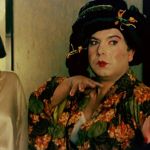
Why does Italian TV still make racist humor in 2021?
Striscia la Notizia's last episode highlighted the cultural gap between television and the real world
April 14th, 2021
Yesterday Striscia La Notizia ended up in the crosshairs of Diet Prada after Gerry Scotti and Michelle Hunziker decided to do the imitation of a very stereotypical version of a Chinese in Italy, complete with fake accents and almond-shaped eyes. An episode that was just the latest in a long series of gaffes that took place live on television in Italy, including the unfortunate episode of Valeria Fabrizi in A Ruota Libera and a fairly offensive archive video also published by Striscia La Notizia some time ago that included the use of blackface and a series of racial epithets. The real problem, however, is the absolute nonchalanche with which these episodes happen and are later treated by the public. Is it possible that no one from the network thought it wasn't appropriate to do so?
To make matters worse, Michelle Hunziker, who today published two short Instagram stories of excuses without showing proactive attitudes towards the problem, but simply hoping for a generic forgive-and-forget that the Italian public is happy to impart to anyone. The reactions and the fact that mainstream programmes continue to stumble across incidents of racism that cannot be tolerated in other countries shows cultural polarisation among the new generations demanding at least decent attention to the problem and a majority of the public for whom the multiculturalism of society simply does not exist.
Italian television is made for boomers – a generation that came to terms with the growing multiculturalism of Italian society in the 80s and 90s to the sound of bad jokes, shaped in particular by the liberalisation of networks and berlusconism. After 30 years, society has changed, despite the representation that the media make of it, multiculturalism is a reality. This is why in recent years public television has become the main field of cultural confrontation between a generation that still thinks in terms of 80s humor and a younger generation, already accustomed to cultural integration, so any racial stereotype (an unrealistic African or Asian accent, for example) is neither funny nor harmless.
Shows such as Striscia are the result of a humor still linked to racial stereotypes that Italian comedy has carried with it practically always and that has seen its exploit in the 80s especially in the demented comedies of Lino Banfi (Domenica, sabato e venerdì would be a great example) and in various cinepanettoni including Vacanze di Natale '83 and Merry Christmas. This humor is also widespread on television, from Marco Marzocca imitating a Filipino in Zelig to that unexploded bomb of controversy that is Ciao Darwin. The problem with this side of Italian comedy is not so much open and actively malicious racism, but the attachment to an antiquated humor that, seen today, is also a little embarrassing.
If Italian society is so nonchalant and frankly over-the-top on the issue of racism, it is also because its comedians have validated certain stereotypes with impunity for decades. In short, it's time to grow up for Italian comedy as well. In a way that does not involve rewriting or erasing the past, which should still be reread critically, but which at least makes producers, authors, comedians themselves and finally the home audience accountable that certain stereotypes are not only offensive and inadequate for healthy comedy, but have never were funny in the first place.





































.jpg)










.jpg)









.jpg)

.jpg)
